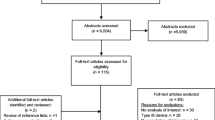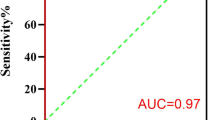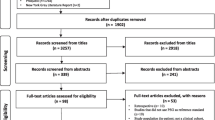Abstract
Background
Obstructive sleep apnoea (OSA) is an increasing health problem in children. The "gold standard" for OSA diagnosis at the moment is overnight polysomnography (PSG). Some researchers think portable monitors (PMs) are promising methods for diagnosing OSA, which make children more comfortable and lower costs. Compared with PSG, our comprehensively evaluated the diagnostic accuracy of PMs for diagnosing OSA in pediatrics.
Research question
This study aims to determine whether PMs can replace PSG in pediatric OSA diagnosis.
Study design and methods
The PubMed, Embase, Medline databases Scopus, Web of Science, and Cochrane Library databases were searched systematically for studies published up to December 2022, evaluating the ability of PMs to diagnose OSA in children. For estimating the pooled sensitivity and specificity of the PMs in the included studies, we used a random-effects bivariate model. Studies included in this meta-analysis were evaluated systematically according to QUADAS-2 guidelines for assessing diagnostic accuracy studies. Two independent investigators conducted each stage of the review independently.
Results
A total of 396 abstracts and 31 full-text articles were screened, and 41 full-text articles were chosen for final review. There were 707 pediatric patients enrolled in these twelve studies, and 9 PMs were evaluated. There was a wide range of diagnostic sensitivity and specificity among PM systems as compared to AHI measured by PSG. The pooled sensitivity and specificity in diagnosing pediatric OSA were, respectively, 0.91 [0.86, 0.94] and 0.76 [0.58, 0.88] for PMs. According to the summary receiver operating characteristic (SROC) curve, the AUC of PMs in diagnosing OSA in pediatric population was 0.93 [0.90, 0.95].
Interpretation
PMs were more sensitive but slightly less specific for pediatric OSA. The combination of PMs and questionnaires appeared to be a reliable tool for the diagnosis of pediatric OSA. This test may be used for screening subjects or populations at high risk of OSA when there is a high demand for PSG, but the quantity is limited. No clinical trial was involved in the current study.





Similar content being viewed by others
Data availability
The corresponding author will make data available upon reasonable request.
Abbreviations
- OS:
-
Oxygen saturation
- BP:
-
Body position
- CDE:
-
Chin and diaphragm electromyography
- EEG:
-
Electroencephalogram
- EU:
-
Electrooculography
- NP:
-
Nasal pressure
- OSA:
-
Obstructive sleep apnea
- PSG:
-
Polysomnography
- PMs:
-
Portable monitors
References
Lumeng JC, Chervin RD (2008) Epidemiology of pediatric obstructive sleep apnea. Proc Am Thorac Soc 5(2):242–252. https://doi.org/10.1513/pats.200708-135MG
Marcus CL, Brooks LJ, Draper KA et al (2012) Diagnosis and management of childhood obstructive sleep apnea syndrome. Pediatrics 130(3):576–584. https://doi.org/10.1542/peds.2012-1671
Eckert DJ, Malhotra A (2008) Pathophysiology of adult obstructive sleep apnea. Proc Am Thorac Soc 5(2):144–153. https://doi.org/10.1513/pats.200707-114MG
Garetz SL (2008) Behavior, cognition, and quality of life after adenotonsillectomy for pediatric sleep-disordered breathing: summary of the literature. Otolaryngol Head Neck Surg 138(1 Suppl):S19-26. https://doi.org/10.1016/j.otohns.2007.06.738
Enright PL, Goodwin JL, Sherrill DL, Quan JR, Quan SF, Tucson Children’s Assessment of Sleep Apneas (2003) Blood pressure elevation associated with sleep-related breathing disorder in a community sample of white and Hispanic children: the Tucson Children’s Assessment of Sleep Apnea study. Arch Pediatr Adolesc Med. 157(9):901–904. https://doi.org/10.1001/archpedi.157.9.901
Beebe DW, Ris MD, Kramer ME, Long E, Amin R (2010) The association between sleep disordered breathing, academic grades, and cognitive and behavioral functioning among overweight subjects during middle to late childhood. Sleep 33(11):1447–1456. https://doi.org/10.1093/sleep/33.11.1447
Hunter SJ, Gozal D, Smith DL, Philby MF, Kaylegian J, Kheirandish-Gozal L (2016) Effect of sleep-disordered breathing severity on cognitive performance measures in a large community cohort of young school-aged children. Am J Respir Crit Care Med 194(6):739–747. https://doi.org/10.1164/rccm.201510-2099OC
Brouillette RT, Fernbach SK, Hunt CE (1982) Obstructive sleep apnea in infants and children. J Pediatr 100(1):31–40. https://doi.org/10.1016/s0022-3476(82)80231-x
Richards W, Ferdman RM (2000) Prolonged morbidity due to delays in the diagnosis and treatment of obstructive sleep apnea in children. Clin Pediatr (Phila) 39(2):103–108. https://doi.org/10.1177/000992280003900205
Berry RB, Budhiraja R, Gottlieb DJ et al (2012) Rules for scoring respiratory events in sleep: update of the 2007 AASM manual for the scoring of sleep and associated events. Deliberations of the sleep apnea definitions task force of the american academy of sleep medicine. J Clin Sleep Med 8(5):597–619. https://doi.org/10.5664/jcsm.2172
Fiorillo L, Puiatti A, Papandrea M et al (2019) Automated sleep scoring: a review of the latest approaches. Sleep Med Rev 48:101204. https://doi.org/10.1016/j.smrv.2019.07.007
Kwon S, Kim H, Yeo WH (2021) Recent advances in wearable sensors and portable electronics for sleep monitoring. iScience 24(5):102461. https://doi.org/10.1016/j.isci.2021.102461
Kapur VK, Auckley DH, Chowdhuri S et al (2017) Clinical practice guideline for diagnostic testing for adult obstructive sleep apnea: an American Academy of Sleep Medicine Clinical Practice Guideline. J Clin Sleep Med 13(3):479–504. https://doi.org/10.5664/jcsm.6506
Tan HL, Kheirandish-Gozal L, Gozal D (2015) Pediatric home sleep apnea testing: slowly getting there! Chest 148(6):1382–1395. https://doi.org/10.1378/chest.15-1365
Kirk V, Baughn J, D’Andrea L et al (2017) American academy of sleep medicine position paper for the use of a home sleep apnea test for the diagnosis of OSA in children. J Clin Sleep Med 13(10):1199–1203. https://doi.org/10.5664/jcsm.6772
Yang B, Mallett S, Takwoingi Y et al (2021) QUADAS-C: a tool for assessing risk of bias in comparative diagnostic accuracy studies. Ann Intern Med 174(11):1592–1599. https://doi.org/10.7326/M21-2234
Whiting PF, Rutjes AW, Westwood ME et al (2011) QUADAS-2: a revised tool for the quality assessment of diagnostic accuracy studies. Ann Intern Med 155(8):529–536. https://doi.org/10.7326/0003-4819-155-8-201110180-00009
Lesser DJ, Haddad GG, Bush RA, Pian MS (2012) The utility of a portable recording device for screening of obstructive sleep apnea in obese adolescents. J Clin Sleep Med 8(3):271–277. https://doi.org/10.5664/jcsm.1912
Massicotte C, Al-Saleh S, Witmans M, Narang I (2014) The utility of a portable sleep monitor to diagnose sleep-disordered breathing in a pediatric population. Can Respir J 21(1):31–35. https://doi.org/10.1155/2014/271061
Chao C, Dabo L, Yujing Y, Xinhua Y (2015) Clinical research on micro-movement sensitive mattress sleep monitoring system in children with obstructive sleep apnea hypopnea syndrome. Zhonghua Er Bi Yan Hou Tou Jing Wai Ke Za Zhi 50(3):215–220
Su M, Yu C, Zhang Y et al (2015) Clinical value of portable sleep testing in children with obstructive sleep apnea syndrome. Zhonghua er ke za zhi Chin J Pediatr 53(11):845–849
Choi JH, Lee B, Lee JY, Kim HJ (2018) Validating the watch-PAT for diagnosing obstructive sleep apnea in adolescents. J Clin Sleep Med 14(10):1741–1747. https://doi.org/10.5664/jcsm.7386
Ikizoglu NB, Kiyan E, Polat B, Ay P, Karadag B, Ersu R (2019) Are home sleep studies useful in diagnosing obstructive sleep apnea in children with down syndrome? Pediatr Pulmonol 54(10):1541–1546. https://doi.org/10.1002/ppul.24440
Masoud AI, Patwari PP, Adavadkar PA, Arantes H, Park C, Carley DW (2019) Validation of the MediByte portable monitor for the diagnosis of sleep apnea in pediatric patients. J Clin Sleep Med 15(5):733–742. https://doi.org/10.5664/jcsm.7764
Bhattacharjee R, Benjafield A, Blase A et al (2021) The accuracy of a portable sleep monitor to diagnose obstructive sleep apnea in adolescent patients. J Clin Sleep Med 17(7):1379–1387. https://doi.org/10.5664/jcsm.9202
Withers A, Maul J, Rosenheim E, O’Donnell A, Wilson A, Stick S (2022) Comparison of home ambulatory type 2 polysomnography with a portable monitoring device and in-laboratory type 1 polysomnography for the diagnosis of obstructive sleep apnea in children. J Clin Sleep Med 18(2):393–402. https://doi.org/10.5664/jcsm.9576
Garde A, Karlen W, Dehkordi P, Wensley D, Ansermino JM, Dumont GA (2013) Oxygen saturation in children with and without obstructive sleep apnea using the phone-oximeter. Annu Int Conf IEEE Eng Med Biol Soc 2013:2531–2534. https://doi.org/10.1109/EMBC.2013.6610055
Garde A, Dehkordi P, Karlen W, Wensley D, Ansermino JM, Dumont GA (2014) Development of a screening tool for sleep disordered breathing in children using the phone Oximeter. PLoS ONE 9(11):e112959. https://doi.org/10.1371/journal.pone.0112959
Alvarez D, Alonso-Alvarez ML, Gutierrez-Tobal GC et al (2017) Automated screening of children with obstructive sleep apnea using nocturnal oximetry: an alternative to respiratory polygraphy in unattended settings. J Clin Sleep Med 13(5):693–702. https://doi.org/10.5664/jcsm.6586
Berry RB, Brooks R, Gamaldo C et al (2017) AASM scoring manual updates for 2017 (version 2.4). J Clin Sleep Med 13(5):665–666. https://doi.org/10.5664/jcsm.6576
Chervin RD, Hedger K, Dillon JE, Pituch KJ (2000) Pediatric sleep questionnaire (PSQ): validity and reliability of scales for sleep-disordered breathing, snoring, sleepiness, and behavioral problems. Sleep Med 1(1):21–32. https://doi.org/10.1016/s1389-9457(99)00009-x
Ehsan Z, Kercsmar CM, Collins J, Simakajornboon N (2017) Validation of the pediatric sleep questionnaire in children with asthma. Pediatr Pulmonol 52(3):382–389. https://doi.org/10.1002/ppul.23568
El Shayeb M, Topfer LA, Stafinski T, Pawluk L, Menon D (2014) Diagnostic accuracy of level 3 portable sleep tests versus level 1 polysomnography for sleep-disordered breathing: a systematic review and meta-analysis. CMAJ 186(1):E25-51. https://doi.org/10.1503/cmaj.130952
Funding
Supported by National Science Foundation of China (No. 82071033 [to X. C.]).
Author information
Authors and Affiliations
Contributions
XC and AT proposed the topic for the meta-analysis. AT and ZL performed the literature search and study selection and produced the figures and tables. AT extracted the data and assessed the qualities of these studies and performed the data analysis. XC and ZL checked the data. AT prepared the manuscript and XC revised the manuscript.
Corresponding author
Ethics declarations
Conflict of interest
The authors have no funding, financial relationships, or conflicts of interest to disclose.
Ethical approval
Not required.
Additional information
Publisher's Note
Springer Nature remains neutral with regard to jurisdictional claims in published maps and institutional affiliations.
Rights and permissions
Springer Nature or its licensor (e.g. a society or other partner) holds exclusive rights to this article under a publishing agreement with the author(s) or other rightsholder(s); author self-archiving of the accepted manuscript version of this article is solely governed by the terms of such publishing agreement and applicable law.
About this article
Cite this article
Tuohuti, A., Lin, Z., Cai, J. et al. Can portable sleep monitors replace polysomnography for diagnosis of pediatric OSA: a systematic review and meta-analysis. Eur Arch Otorhinolaryngol 280, 4351–4359 (2023). https://doi.org/10.1007/s00405-023-08095-6
Received:
Accepted:
Published:
Issue Date:
DOI: https://doi.org/10.1007/s00405-023-08095-6




